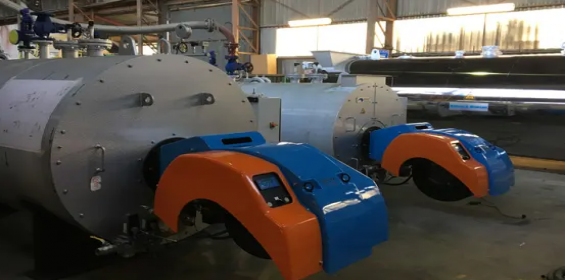The UK is in the midst of an energy crises and, while many manufacturers have purchased energy supplies in advance, as these contracts end, they will have to renegotiate and secure energy supplies for the coming years during this high price period. Concurrently, industry is tasked with bringing all GHG emissions to net zero by 2050.
These two key challenges have resulted in a focus on developing and employing mature energy efficiency and decarbonisation technologies. When it comes to heat raising systems, it’s undeniable that these use particularly large quantities of energy, but manufacturers of these systems have invested considerable R&D resources into improving their energy efficiency and emissions.
Steam generation
Fire tube and coil type steam generators produce ‘dry’ saturated steam to maximise the delivery of heat to the user. They are ideal for use where both direct and indirect heating are required simultaneously and where heat transfer at a constant temperature is required.
Both types operate along the same basic principles in that water is confined in a restricted space and is heated by burning a fuel source. The energy of combustion is transferred from the flame to the water by radiation and conduction, heating the water and ultimately raising steam.
Modern steam generators have progressed considerably and now include a very accurately controlled burner which creates a defined heat input to a double coil of steel tube through which a precise quantity of feed water is pumped. Only a small amount of excess water is fed into the coil to provide the correct operating conditions at all times and a steam/water separator is usually incorporated at the coil outlet to ensure dry steam is provided to the process.
Using this method, steam generators consume less energy as they only fire on demand for steam from the process, and can be very quickly brought up to working pressure when steam is required. This means the bare minimum of standing losses resulting in reduced overall emissions.
Developments have also been made to improve overall efficiency and control of tube boilers and burners, which also means reduced fuel demand, better control of the burner, and improved emissions. At the Real Petfood Company’s manufacturing facility in Bodelwyddan, north east Wales, a Babcock Wanson BWD40 Fire Tube Boiler is being used to heat retort cookers and mixing vessels for baked pet treats. It was chosen due to its high efficiency, long-life and low-cost maintenance. Efficiency comes as a result of the optimised matching of the boiler shell and the burner, along with advanced burner head geometry which provides stable combustion with near constant efficiency throughout the complete burner modulating range. Using Babcock Wanson’s latest micro-modulation Optimo burner, the BWD40 has emission rates of less than 100mg/Nm3 NOx throughout the firing range when burning natural gas, making it one of the best performing burners on the market. Further efficiencies of 95% have been achieved with the installation of a Babcock Wanson matched economiser at the Real Petfood Company.
Thermal fluid heaters
Where practically possible, thermal fluid heaters have been rapidly replacing steam generating equipment because they are considerably more energy efficient, have fewer overall emissions, are safer and easier to use, and have a smaller footprint so can be located at point of use.
Thermal fluid heating is based on a similar basic principle to a low-pressure hot water system. It consists of a heater connected to carbon steel flow and return pipework which can provide heat to one or more users or systems. Instead of water running through the pipework, a thermal fluid is used as the heat transfer medium.
This simple and easily automated closed loop design, allowing for high temperatures (up to 350°C in standard form), means thermal fluid heating systems can use 20-50% less energy overall to transfer the same amount of heat when compared to steam generators.
Thermal fluid systems are incredibly versatile, so are used in numerous different industries and applications, with the most common being pressing, curing and moulding; tanks, vessels and cookers; printing, coating, laminating and drying; and heating and cooling systems. For example, Blackburn Chemicals Ltd., a world leader in foam control and antifoaming solutions, uses a Babcock Wanson EPC1000ES Thermal Fluid Heater to heat process vessels. The EPC ES is a fully automatic coil type, multi-pass thermal fluid heater which precisely matches fuel input to plant energy requirements. At Blackburn Chemicals, the heater’s energy efficiency is further enhanced through the addition of a Babcock Wanson in-built exhaust gas to combustion air economiser.
Massive gains have been made in making process heating systems more energy efficient and, in doing so, have also reduced emissions. With energy costs continuing to rise and likely to remain high for the foreseeable future, plus net zero on the horizon, reviewing your choice of heat raising systems and opting for modern energy efficient equipment has never seemed more important.
https://twitter.com/babcockwanson
https://www.linkedin.com/company/babcock-wanson/

